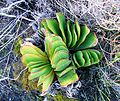| Kumara | |
|---|---|
 | |
| Fan-aloe, Kumara plicatilis | |
| Scientific classification | |
| Kingdom: | Plantae |
| Clade: | Tracheophytes |
| Clade: | Angiosperms |
| Clade: | Monocots |
| Order: | Asparagales |
| Family: | Asphodelaceae |
| Subfamily: | Asphodeloideae |
| Tribe: | Aloeae |
| Genus: | Kumara Medik., nom. cons. [1] |
| Type species | |
| Kumara disticha | |
Kumara is a genus of two species of flowering plants in the subfamily Asphodeloideae, native to the Western Cape Province of South Africa. [2] [3]

